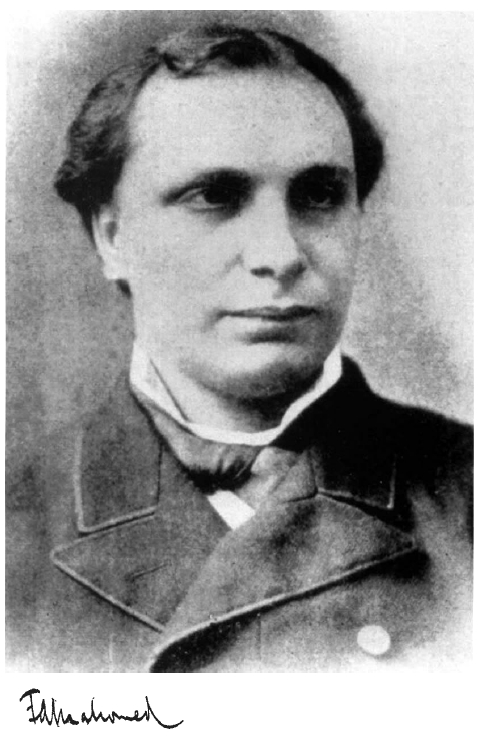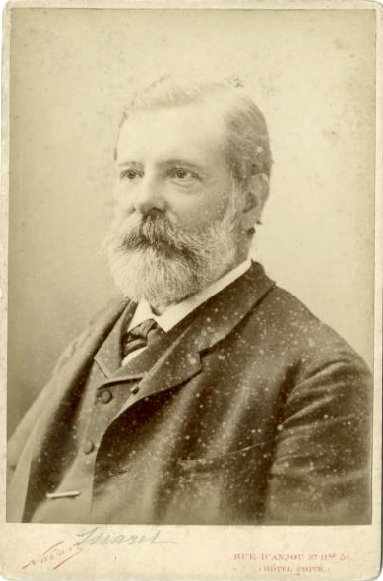|
Sphygmograph
The sphygmograph ( ) was a mechanical device used to measure blood pressure in the mid-19th century. It was developed in 1854 by German physiologist Karl von Vierordt (1818–1884). It is considered the first external, non-intrusive device used to estimate blood pressure. The device was a system of levers hooked to a scale-pan in which weights were placed to determine the amount of external pressure needed to stop blood flow in the radial artery. Although the instrument was cumbersome and its measurements imprecise, the basic concept of Vierordt's sphygmograph eventually led to the blood pressure cuff used today. In 1863, Étienne-Jules Marey (1830–1904) improved the device by making it portable. Also he included a specialized instrument to be placed above the radial artery that was able to magnify pulse waves and record them on paper with an attached pen. In 1872, Frederick Akbar Mahomed published a description of a modified sphygmograph. This modified version made the sphygmo ... [...More Info...] [...Related Items...] OR: [Wikipedia] [Google] [Baidu] |
Frederick Akbar Mahomed
Frederick Henry Horatio Akbar Mahomed (11 April 1849 – 22 November 1884) was an internationally known British physician from Brighton, England. Family and personal life Frederick Henry Horatio Akbar Mahomed was born on 11 April 1849 in Brighton. He was the eldest son of Frederick Mahomed (1818–1888) and his second wife, Sarah Hodgkinson (1816–1905). He was also the grandson of the pioneering Indian traveller, author and entrepreneur Sake Dean Mahomed. Frederick Akbar Mahomed's father, Frederick Mahomed, ran a fencing, gymnastics and callisthenics academy in Hove, which included boxing instruction. Cameron and Hicks dispute the suggestion that he ran Turkish baths at Brighton attributing this to a confusion of Mahomed's father Frederick with his uncle, Arthur. Mahomed had three brothers (Arthur George Suleiman, James Deen Kerriman and Henry), and one sister (Adeline). He was educated privately in Brighton prior to attending medical school. On June 14, 1873, at the parish ... [...More Info...] [...Related Items...] OR: [Wikipedia] [Google] [Baidu] |
Étienne-Jules Marey
Étienne-Jules Marey (; 5 March 1830, Beaune, Côte-d'Or – 15 May 1904, Paris) was a French scientist, physiologist and chronophotographer. His work was significant in the development of cardiology, physical instrumentation, aviation, cinematography and the science of laboratory photography. He is widely considered to be a pioneer of photography and an influential pioneer of the history of cinema. He was also a pioneer in establishing a variety of graphical techniques for the display and interpretation of quantitative data from physiological measurement. Biography Marey started by studying Circulatory system, blood circulation in the human body. Then he shifted to analyzing heart beats, respiration, muscles (myography), and movement of the body. To aid his studies he developed many instruments for precise measurements. For example, in 1859, in collaboration with the physiologist Auguste Chauveau and the watch manufacturer Breguet (brand), Breguet, he developed a wearable ' ... [...More Info...] [...Related Items...] OR: [Wikipedia] [Google] [Baidu] |
Karl Von Vierordt
Karl von Vierordt (July 1, 1818 – November 22, 1884) was a German physiologist. Vierordt was born in Lahr, Baden. He studied at the universities of Berlin, Göttingen, Vienna, and Heidelberg, and began a practice in Karlsruhe in 1842. In 1849 he became a professor of theoretical medicine at the University of Tübingen, and in 1853 a professor of physiology. Vierordt developed techniques and tools for the monitoring of blood circulation. He is credited with the construction of an early "hemotachometer", an apparatus for monitoring the velocity of blood flow. In 1854, he created a device called a sphygmograph, a mechanism consisting of weights and levers used to estimate blood pressure, and considered to be a forerunner of the modern sphygmomanometer. One of his better known written works was a treatise on the arterial pulse, titled ''Die Lehre vom Arterienpuls in gesunden und kranken Zuständen''. Vierordt also made substantial contributions to the psychology of time perc ... [...More Info...] [...Related Items...] OR: [Wikipedia] [Google] [Baidu] |
Blood Pressure
Blood pressure (BP) is the pressure of circulating blood against the walls of blood vessels. Most of this pressure results from the heart pumping blood through the circulatory system. When used without qualification, the term "blood pressure" refers to the pressure in the large arteries. Blood pressure is usually expressed in terms of the systolic pressure (maximum pressure during one heartbeat) over diastolic pressure (minimum pressure between two heartbeats) in the cardiac cycle. It is measured in millimeters of mercury ( mmHg) above the surrounding atmospheric pressure. Blood pressure is one of the vital signs—together with respiratory rate, heart rate, oxygen saturation, and body temperature—that healthcare professionals use in evaluating a patient's health. Normal resting blood pressure, in an adult is approximately systolic over diastolic, denoted as "120/80 mmHg". Globally, the average blood pressure, age standardized, has remained about the same since 1 ... [...More Info...] [...Related Items...] OR: [Wikipedia] [Google] [Baidu] |
Physiologist
Physiology (; ) is the scientific study of functions and mechanisms in a living system. As a sub-discipline of biology, physiology focuses on how organisms, organ systems, individual organs, cells, and biomolecules carry out the chemical and physical functions in a living system. According to the classes of organisms, the field can be divided into medical physiology, animal physiology, plant physiology, cell physiology, and comparative physiology. Central to physiological functioning are biophysical and biochemical processes, homeostatic control mechanisms, and communication between cells. ''Physiological state'' is the condition of normal function. In contrast, ''pathological state'' refers to abnormal conditions, including human diseases. The Nobel Prize in Physiology or Medicine is awarded by the Royal Swedish Academy of Sciences for exceptional scientific achievements in physiology related to the field of medicine. Foundations Cells Although there are difference ... [...More Info...] [...Related Items...] OR: [Wikipedia] [Google] [Baidu] |
Radial Artery
In human anatomy, the radial artery is the main artery of the lateral aspect of the forearm. Structure The radial artery arises from the bifurcation of the brachial artery in the antecubital fossa. It runs distally on the anterior part of the forearm. There, it serves as a landmark for the division between the anterior compartment of the forearm, anterior and posterior compartment of the forearm, posterior compartments of the forearm, with the posterior compartment beginning just lateral to the artery. The artery winds laterally around the wrist, passing through the anatomical snuff box and between the heads of the first dorsal interossei of the hand, dorsal interosseous muscle. It passes anteriorly between the heads of the adductor pollicis, and becomes the deep palmar arch, which joins with the deep branch of the ulnar artery. Along its course, it is accompanied by a similarly named vein, the radial vein. Branches The named branches of the radial artery may be divided into ... [...More Info...] [...Related Items...] OR: [Wikipedia] [Google] [Baidu] |
Blood Pressure Cuff
A sphygmomanometer ( ), a blood pressure monitor, or blood pressure gauge, is a device used to measure blood pressure, composed of an inflatable cuff to collapse and then release the artery under the cuff in a controlled manner, and a mercury or aneroid manometer to measure the pressure. Manual sphygmomanometers are used with a stethoscope when using the auscultatory technique. A sphygmomanometer consists of an inflatable cuff, a measuring unit (the mercury manometer, or aneroid gauge), and a mechanism for inflation which may be a manually operated bulb and valve or a pump operated electrically. Types Both manual and digital meters are currently employed, with different trade-offs in accuracy versus convenience. Manual A stethoscope is required for auscultation ( see below). Manual meters are best used by trained practitioners, and, while it is possible to obtain a basic reading through palpation alone, this yields only the systolic pressure. * Mercury sphygmomanomet ... [...More Info...] [...Related Items...] OR: [Wikipedia] [Google] [Baidu] |
Pulse Wave
A pulse wave or pulse train is a type of non-sinusoidal waveform that includes square waves (duty cycle of 50%) and similarly periodic but asymmetrical waves (duty cycles other than 50%). It is a term used in synthesizer programming, and is a typical waveform available on many synthesizers. The exact shape of the wave is determined by the duty cycle or pulse width of the oscillator output. In many synthesizers, the duty cycle can be modulated (pulse-width modulation) for a more dynamic timbre.Reid, Gordon (February 2000). Synth Secrets: Modulation, ''SoundOnSound.com''. Retrieved May 4, 2018. The pulse wave is also known as the rectangular wave, the periodic version of the rectangular function. The average level of a rectangular wave is also given by the duty cycle, therefore by varying the on and off periods and then averaging these said periods, it is possible to represent any value between the two limiting levels. This is the basis of pulse-width modulation. Frequency-do ... [...More Info...] [...Related Items...] OR: [Wikipedia] [Google] [Baidu] |
Blood Pressure
Blood pressure (BP) is the pressure of circulating blood against the walls of blood vessels. Most of this pressure results from the heart pumping blood through the circulatory system. When used without qualification, the term "blood pressure" refers to the pressure in the large arteries. Blood pressure is usually expressed in terms of the systolic pressure (maximum pressure during one heartbeat) over diastolic pressure (minimum pressure between two heartbeats) in the cardiac cycle. It is measured in millimeters of mercury ( mmHg) above the surrounding atmospheric pressure. Blood pressure is one of the vital signs—together with respiratory rate, heart rate, oxygen saturation, and body temperature—that healthcare professionals use in evaluating a patient's health. Normal resting blood pressure, in an adult is approximately systolic over diastolic, denoted as "120/80 mmHg". Globally, the average blood pressure, age standardized, has remained about the same since 1 ... [...More Info...] [...Related Items...] OR: [Wikipedia] [Google] [Baidu] |
Samuel Siegfried Karl Ritter Von Basch
Samuel Siegfried Karl ''Ritter'' von Basch (9 September 1837, Prague25 April 1905) was an Austrian-Jewish (Yekke) physician who was best known as the personal physician of emperor Maximilian of Mexico and the inventor of the blood pressure meter (also known as sphygmomanometer). Basch was educated at Charles University in Prague and the University of Vienna. From 1857 he studied chemistry at the laboratory of Ernst Wilhelm von Brücke in Vienna, and five years later began the practice of medicine. From that time until 1865 he was assistant to Leopold Ritter von Dittel, Eduard Jäger von Jaxtthal, Ludwig Türck and Eugen Kolisko (18111884) at the University of Vienna. In 1864, Basch was appointed chief surgeon of the military hospital at Puebla, Mexico. Soon after that, he was appointed as Maximilian's personal physician. Basch remained with Maximilian until the emperor's execution by firing squad at Querétaro on 19 June 1867. When Maximilian realized that a few days at the most ... [...More Info...] [...Related Items...] OR: [Wikipedia] [Google] [Baidu] |
Sphygmomanometer
A sphygmomanometer ( ), a blood pressure monitor, or blood pressure gauge, is a device used to measure blood pressure, composed of an inflatable cuff to collapse and then release the artery under the cuff in a controlled manner, and a mercury (element), mercury or Pressure measurement#Aneroid, aneroid manometer to measure the pressure. Manual sphygmomanometers are used with a stethoscope when using the Auscultation, auscultatory technique. A sphygmomanometer consists of an inflatable cuff, a measuring unit (the Pressure measurement#Liquid column (manometer), mercury manometer, or aneroid gauge), and a mechanism for inflation which may be a manually operated bulb and valve or a pump operated electrically. Types Both manual and digital meters are currently employed, with different trade-offs in accuracy versus convenience. Manual A stethoscope is required for auscultation (#A stethoscope is required for auscultation (see below), see below). Manual meters are best used by trai ... [...More Info...] [...Related Items...] OR: [Wikipedia] [Google] [Baidu] |






